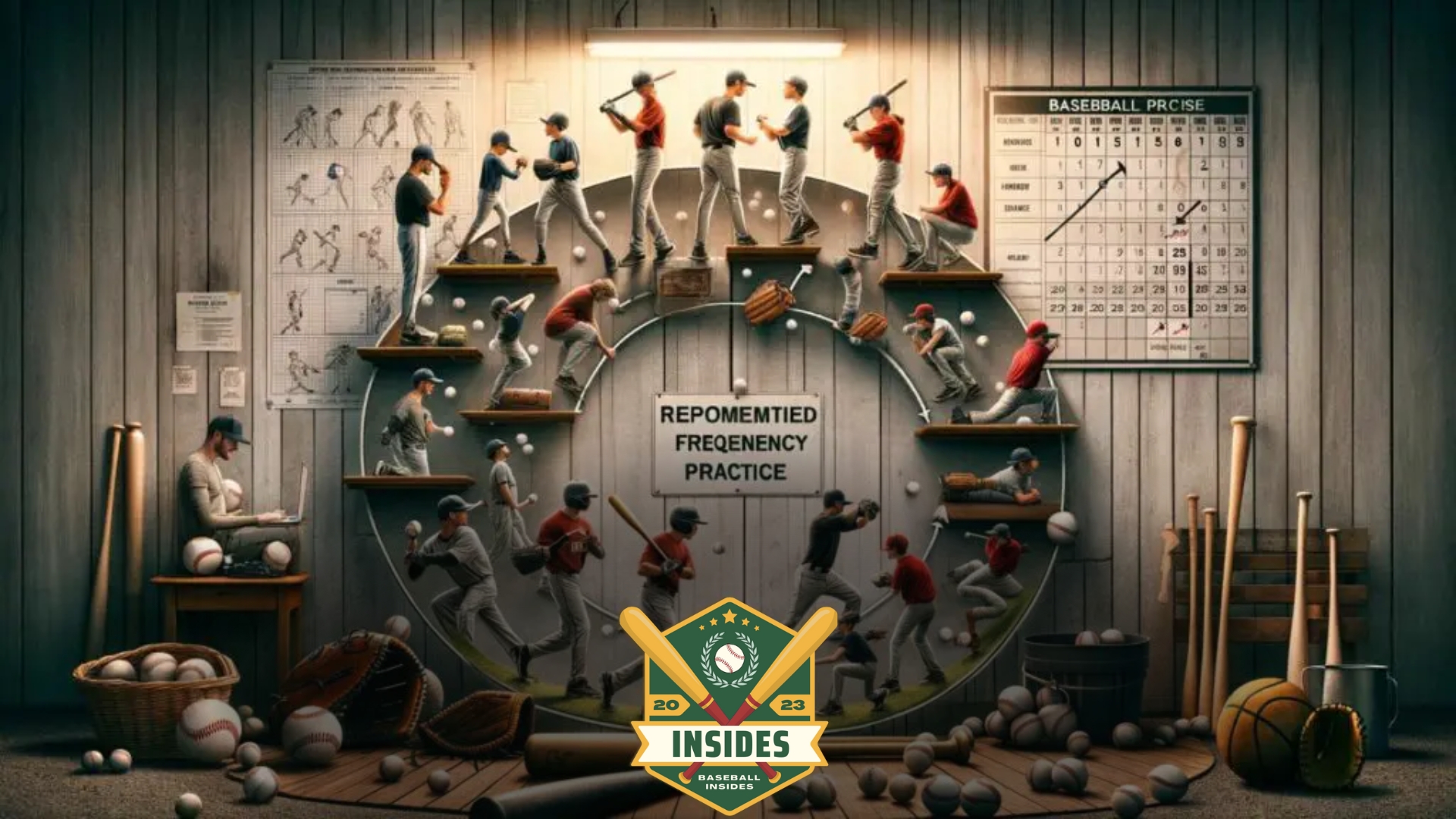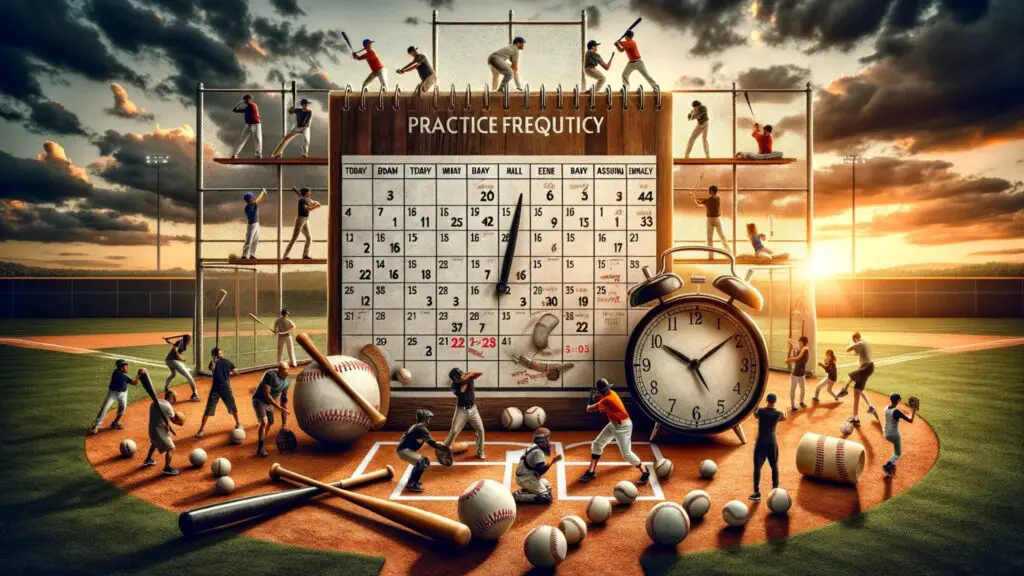
In this article:
Baseball practice should occur at least 3-5 times per week to maintain and improve skills. Consistency is key for both beginners and advanced players.
Baseball, a sport steeped in technique and coordination, requires regular practice to hone the intricate skills necessary for success on the field.
Aspiring players and seasoned athletes must dedicate time to training, focusing on physical conditioning and technical drills.
A routine that balances batting, fielding, pitching, and strategic play is essential for comprehensive development.
Engaging in practice several times a week allows players to work on weaknesses, enhance strengths, and stay sharp throughout the season.
By committing to a consistent practice schedule, players can optimize their performance and elevate their game, regardless of their experience level.
The Importance of Regular Practice
Imagine stepping onto the baseball field with confidence. Regular practice is key. It helps players refine skills and stay sharp.
Think about practice as your secret weapon. It builds strength, improves coordination, and boosts your game IQ.
Building Muscle Memory
Baseball demands quick thinking and fast reactions. Muscle memory plays a huge part in this.
Repetition is the magic word. Swing that bat often. Catch and throw daily.
- Repeat drills to perfect your swing.
- Use various pitches to enhance adaptability.
- Focus on your fielding stance in different situations.
Each practice session adds to your muscle memory. Soon, your body knows what to do before your brain tells it.
Developing Consistency
Steady practice leads to steady improvement. Your throws become more accurate. Your hits get harder.
It’s all about turning good days into great ones and bad days into better ones.
| Practice Frequency | Skills Improved |
|---|---|
| Daily | Reflexes, Stamina |
| Every Other Day | Technique, Strategy |
| Weekly | Consistency, Team Play |
Consistent practice sharpens skills. Even when you can’t team up, work on the basics. Throw it against a wall.
Swing in your backyard. Keep your game on point, always ready for the next pitch.
Tailoring Your Practice Schedule
A one-size-fits-all practice schedule doesn’t cut you when perfecting your baseball skills. It’s about finding what works uniquely for you.
Creating a practice plan tailored to your rhythm can optimize your performance on the diamond.
Dive into customizing your routine with the guidance below.
Assessing Personal Goals
Setting clear objectives is crucial for fostering growth in any athlete’s journey. Think about what you aim to achieve.
Are you looking to improve your batting average, pitching speed, or defensive skills? Your goals will dictate the specifics of your practice schedule.
- Determine short-term targets – like mastering a new pitch or honing your swing mechanics.
- Establish long-term ambitions – think about where you see your baseball career in years ahead.
Once goals are in place, your practice frequency and focus areas become clearer, setting a path for consistent development.
Managing Time Effectively
Every player juggles various commitments. Effective time management ensures quality practice without burnout. Evaluate your weekly schedule.
Identify blocks of time dedicated to practice while balancing rest and other life responsibilities.
| Day of Week | Practice Focus | Duration | Rest |
|---|---|---|---|
| Monday | Hitting Drills | 1 hour | 8 hours |
| Tuesday | Defensive Work | 1 hour | 8 hours |
| Wednesday | Rest/Recovery | 0 hours | 8 hours |
Incorporate flexibility into your plan to account for unexpected events or days when your body needs extra rest.
Components of An Effective Baseball Practice
Maximizing your baseball potential requires consistent and focused practice. A well-structured training routine goes beyond just playing catch or batting practice.
Varied drills, strength conditioning, and targeted exercises form the backbone of a productive workout.
Drills for Skill Improvement
Effective baseball drills are specific to individual roles on the field and focus on repetitions to build muscle memory.
Here’s a breakdown of essential drills:
- Catching Drills: These improve glove skills and hand-eye coordination.
- Hitting Drills: Hitters work on timing, power, and accuracy.
- Fielding Drills: Infielders and outfielders fine-tune their reaction times.
- Pitching Drills: These enhance control, velocity, and pitching mechanics.
- Base Running Drills: Speed and agility are the main focus here.
Strength and Conditioning
Physical fitness significantly impacts a player’s performance. A well-rounded strength and conditioning program should include:
| Exercise Type | Purpose | Example Workouts |
|---|---|---|
| Cardiovascular Training | Increase stamina | Running, cycling, swimming |
| Strength Training | Build muscle | Weightlifting, resistance exercises |
| Flexibility | Prevent injury | Stretching, yoga |
| Agility Training | Enhance quickness | Ladder drills, cone drills |
Each session should include a warm-up and cool-down phase to reduce injury risk.
Customizing your workouts to address personal strengths and weaknesses will yield the best results.
Practice Intensity and Rest Periods
Mastering baseball skills demands regular practice, but how hard and how often should you train?
Understanding the balance between practice intensity and rest periods is key. It can lead to optimal performance while preventing burnout and injuries.
Understanding the Role of Recovery
Rest is crucial for muscle repair and growth. Without proper recovery, the risk for injury spikes, and performance may decline.
High-intensity training should always be followed by adequate rest to ensure the body has time to recuperate.
Table: Suggested Rest Periods After Different Training Intensities
| Training Intensity | Suggested Rest Period |
|---|---|
| Light Practice | 24 hours |
| Moderate Training | 48 hours |
| High Intensity | 72 hours or more |
A guideline is to include at least one week off to recharge mentally and physically.
Balancing Workouts and Downtime
Balancing intense workouts with downtime is essential. Alternate between skill training, strength conditioning, and rest.
- Begin with lighter drills or practice sessions.
- Progress to more strenuous activities midweek.
- End with a recovery period to prepare for the next cycle.
Keep sessions short and focused; a focused 90-minute session can be more effective than several hours of unfocused practice.
Seasonal Variations in Practice
Baseball athletes know that practice habits shift with the seasons. This change is not just about adapting to weather but for peak performance.
Tailoring your baseball training schedule to the time of year can lead to great success on the field.
Off-season vs. In-season Training
Off-season training is a time for growth. Players can focus on building strength, agility, and endurance without the pressure of upcoming games.
Emphasis on conditioning and technical skills is fundamental during this period.
In contrast, in-season training maintains what you’ve built. The goal is to keep skill levels sharp and prevent injury.
| Season | Focus | Frequency |
|---|---|---|
| Off-Season | Build strength, endurance | 4-6 days a week |
| In-Season | Maintain abilities, prevent injury | 2-3 days a week |
Pre-season Preparation
Pre-season bridges the gap between training phases. It’s a critical time for getting in game shape.
Players intensify baseball-specific drills to ready their bodies and minds for competition.
- Increased drills simulate in-game scenarios.
- Situational practices sharpen decision-making.
- Scrimmages introduce a competitive atmosphere.
Instilling confidence and honing skills are pre-season goals. Aim for 5-6 days a week to maximize readiness.
Monitoring Progress and Modifying Routines
Getting better at baseball means putting in practice time. Yet, knowing how much and how often to practice isn’t always clear.
Monitoring progress and modifying routines is crucial for any player who is serious about their development.
It’s tough to hit those home runs consistently without tracking progress and adjusting training.
Setting Benchmarks for Development
By setting clear, achievable goals, players can see their improvements. These goals range from increasing the batting average to throwing more accurate pitches.
Regular assessment helps players stay on track. To measure progress, consider:
- Game statistics: Track hits, strikeouts, and ERA.
- Practice results: Use a radar gun for pitch speed.
- Physical fitness: Record improvements in strength and agility.
Each player should also have a personal skill checklist.
This checklist can be updated with coaches or mentors to ensure all areas of the game are covered.
Adapting to Performance Feedback
Feedback is a treasure map to success. By analyzing performance, players can identify areas that need work. This may involve:
- Modifying workout intensity.
- Adjusting swing mechanics.
- Focusing on mental conditioning.
Use both positive feedback and constructive criticism to shape your training. Remember, adapting routines is not about overhauling everything.
Small, focused changes often lead to the best results.

Frequently Asked Questions
How Often Should You Practice Hitting a Baseball?
Practice hitting a baseball 3-5 times weekly, focusing on quality swings and consistent form to improve skills and muscle memory.
How Many Days a Week Do MLB Players Practice?
MLB players typically have daily practices or games during the season, averaging six days of activity per week. Off-days are commonly scheduled once a week but can vary.
How Many Swings Should a Baseball Player Take a Day?
A baseball player should aim for 50-100 quality swings daily, focusing on proper technique and consistency. Adjust this number based on individual endurance and training needs.
How Many Pitching Lessons in a Week?
Most players benefit from one to two weekly pitching lessons to allow for practice and muscle recovery.
What is Optimal Baseball Practice Frequency?
Practicing baseball 3-5 times weekly allows for skill improvement and proper rest.
Conclusion
Balancing practice with rest is key to baseball success. Aim for consistent, focused sessions throughout the week.
Remember, quality trumps quantity. Tailor your routine to your personal goals and listen to your body.
Keep swinging, stay healthy, and watch your game soar.






